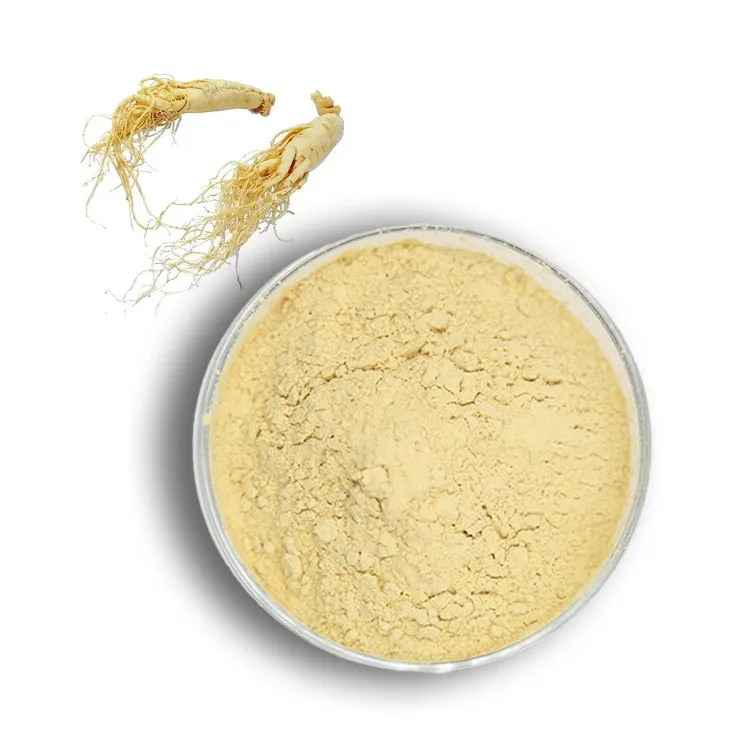- 0086-571-85302990
- sales@greenskybio.com
How to extract ginseng root extract from plants?
2024-11-29

1. Introduction
Ginseng, a renowned plant in traditional medicine, has been highly valued for its potential health benefits. The extraction of Ginseng Root Extract is a crucial process for obtaining the active compounds that can be used in various health - promoting products. This article aims to provide comprehensive knowledge about the extraction process, including different methods, factors influencing extraction efficiency, and ways to ensure the purity and potency of the extract.

2. Different Extraction Approaches
2.1. Solvent Extraction
Solvent extraction is one of the most common methods for obtaining Ginseng Root Extract. Different solvents can be used depending on the target compounds.
- Ethanol extraction: Ethanol is a popular solvent for ginseng extraction. It is effective in extracting a wide range of active ingredients such as ginsenosides. The process typically involves grinding the ginseng roots into a fine powder and then soaking it in ethanol for a certain period. For example, a ratio of 1:5 (ginseng powder: ethanol) may be used, and the mixture is left to soak for about 1 - 2 weeks at room temperature, with occasional shaking. After that, the mixture is filtered to obtain the ethanolic extract.
- Water extraction: Water can also be used as a solvent. It is a more natural and cost - effective option. However, water extraction may result in a different profile of extracted compounds compared to ethanol extraction. The process is similar to ethanol extraction in terms of grinding the roots, but the soaking time may be shorter, usually around 2 - 3 days at a warm temperature (around 40 - 50°C). The water extract can be further concentrated and dried to obtain the ginseng root water extract.
2.2. Supercritical Fluid Extraction
Supercritical fluid extraction (SFE) is a more advanced and environmentally friendly extraction method. Carbon dioxide (CO₂) is often used as the supercritical fluid.
- The ginseng roots are first prepared by drying and grinding them into a suitable particle size.
- The CO₂ is pressurized and heated to reach its supercritical state. In this state, CO₂ has properties between a gas and a liquid, which allows it to penetrate the ginseng root matrix effectively.
- The supercritical CO₂ is then passed through the ginseng root powder in an extraction vessel. The extraction conditions, such as pressure (usually around 10 - 50 MPa), temperature (around 35 - 60°C), and extraction time (1 - 3 hours), can be optimized to achieve the best extraction results. The advantage of SFE is that it can produce a high - quality extract with a relatively pure composition and minimal solvent residue.

3. Factors Affecting Extraction Efficiency
3.1. Particle Size of Ginseng Roots
The particle size of the ginseng roots has a significant impact on the extraction efficiency.
- Smaller particle sizes increase the surface area available for solvent interaction. When the roots are ground into a fine powder, the solvent can more easily penetrate the cell walls and extract the active compounds. For example, if the ginseng roots are coarsely chopped, the extraction may be incomplete as the solvent may not be able to reach all parts of the root tissue effectively.
- However, if the particle size is too small, it may lead to problems such as clogging during filtration. A balance needs to be struck, and typically a particle size in the range of 40 - 80 mesh is considered suitable for most extraction methods.
3.2. Extraction Temperature
Extraction temperature is another crucial factor.
- In solvent extraction, increasing the temperature can generally enhance the solubility of the active compounds in the solvent. For example, in water extraction, a higher temperature (up to a certain limit, usually around 50 - 60°C) can accelerate the extraction process. However, if the temperature is too high, it may cause degradation of some heat - sensitive compounds, such as certain ginsenosides.
- In supercritical fluid extraction, the temperature affects the density and diffusivity of the supercritical fluid. The appropriate temperature range needs to be determined based on the properties of the supercritical fluid and the target compounds to ensure efficient extraction without causing chemical changes to the extract.
3.3. Extraction Time
Extraction time also plays a role in the extraction efficiency.
- For solvent extraction, a longer extraction time usually leads to a higher yield of the extract. However, after a certain point, the increase in yield becomes marginal. For example, in ethanol extraction, extending the soaking time from 1 week to 2 weeks may result in a significant increase in the amount of extracted ginsenosides, but further extending it beyond 2 weeks may not bring a substantial additional yield.
- In supercritical fluid extraction, the extraction time is also an important parameter. A too - short extraction time may result in incomplete extraction, while a too - long extraction time may lead to unnecessary energy consumption and potential degradation of the extract.

4. Ensuring Purity and Potency of the Extract
4.1. Purification Techniques
After the initial extraction, purification techniques are often required to ensure the purity of the Ginseng Root Extract.
- Filtration: Filtration is a basic step to remove solid particles from the extract. Different types of filters can be used, such as filter paper, membrane filters, or sintered filters. Filtration helps to clarify the extract and remove any undissolved plant debris, which is important for subsequent processing steps.
- Chromatography: Chromatography techniques, such as high - performance liquid chromatography (HPLC) or column chromatography, can be used to separate and purify the active compounds in the ginseng root extract. HPLC is a highly precise method that can separate different ginsenosides based on their chemical properties. By using appropriate columns and mobile phases, the individual ginsenosides can be isolated and purified, which is crucial for ensuring the potency and consistency of the extract in health - promoting products.
4.2. Quality Control
Quality control is essential throughout the extraction process to ensure the potency of the ginseng root extract.
- Analysis of active compounds: Regular analysis of the ginsenosides content in the extract is necessary. This can be done using spectroscopic methods such as ultraviolet - visible (UV - Vis) spectroscopy or more advanced techniques like mass spectrometry (MS). By monitoring the ginsenosides content, the quality of the extract can be assessed and compared against established standards.
- Microbial testing: Since ginseng roots are natural products, there is a risk of microbial contamination. Microbiological tests should be carried out to ensure that the extract is free from harmful bacteria, fungi, and other microorganisms. This is especially important for extracts that are intended for use in health - promoting products, as microbial contamination can pose a risk to consumer health.

5. Conclusion
Extracting ginseng root extract is a complex process that involves choosing the appropriate extraction method, considering various factors that affect extraction efficiency, and implementing measures to ensure the purity and potency of the extract. By understanding these aspects, it is possible to produce high - quality ginseng root extract that can be effectively used in health - promoting products. However, it is also important to note that the extraction process should be carried out in compliance with relevant regulations and quality standards to ensure the safety and efficacy of the final product.

FAQ:
Question 1: What are the common methods for extracting ginseng root extract?
There are several common methods for extracting ginseng root extract. One is the solvent extraction method, which uses solvents such as ethanol or water to dissolve the active components in ginseng roots. Another is supercritical fluid extraction, which utilizes supercritical fluids like carbon dioxide under specific pressure and temperature conditions to extract the desired substances. Maceration is also a traditional method where the ginseng roots are soaked in a solvent for a period of time to allow the extraction of components.
Question 2: How do factors like temperature affect the extraction efficiency?
Temperature can have a significant impact on the extraction efficiency. In general, an appropriate increase in temperature can enhance the solubility of the active components in the solvent, thus speeding up the extraction process. However, if the temperature is too high, it may cause the degradation of some heat - sensitive active ingredients in ginseng roots. So, a balance needs to be struck to ensure the maximum extraction of useful components while maintaining their integrity.
Question 3: What steps can be taken to ensure the purity of the ginseng root extract?
To ensure the purity of the ginseng root extract, filtration is an important step. This can remove insoluble impurities from the extract. Purification techniques such as chromatography can also be used to separate and purify the specific active components. Additionally, strict control of the extraction process, including the quality of raw materials and the cleanliness of extraction equipment, helps in maintaining the purity of the extract.
Question 4: How can the potency of the ginseng root extract be maintained during extraction?
To maintain the potency of the ginseng root extract during extraction, gentle extraction conditions are preferred. Avoiding harsh chemicals and extreme processing conditions can prevent the destruction of active components. Also, proper storage of the raw ginseng roots before extraction, such as in a cool and dry place, can help preserve their potency. Using appropriate extraction solvents and methods that are specifically designed to target the active components without causing damage is also crucial.
Question 5: Are there any safety considerations during the extraction of ginseng root extract?
Yes, there are safety considerations during the extraction of ginseng root extract. When using solvents, proper ventilation is necessary to prevent the inhalation of solvent vapors, which may be harmful. Also, the extraction equipment should be maintained and operated correctly to avoid any potential accidents. Moreover, if any additives are used during the extraction process, their safety and regulatory compliance need to be ensured.
Related literature
- Optimization of Ginseng Root Extract Extraction Process"
- "Advanced Techniques for High - Quality Ginseng Root Extract Production"
- "Factors Influencing the Purity and Potency of Ginseng Root Extract in Extraction"
- ▶ Hesperidin
- ▶ citrus bioflavonoids
- ▶ plant extract
- ▶ lycopene
- ▶ Diosmin
- ▶ Grape seed extract
- ▶ Sea buckthorn Juice Powder
- ▶ Beetroot powder
- ▶ Hops Extract
- ▶ Artichoke Extract
- ▶ Reishi mushroom extract
- ▶ Astaxanthin
- ▶ Green Tea Extract
- ▶ Curcumin Extract
- ▶ Horse Chestnut Extract
- ▶ Other Problems
- ▶ Boswellia Serrata Extract
- ▶ Resveratrol Extract
- ▶ Marigold Extract
- ▶ Grape Leaf Extract
- ▶ blog3
- ▶ blog4
-
Chinese Lycopene Powder Factories.
2024-11-29
-
Chinese konjac powder factory.
2024-11-29
-
The Most Worth - Buying Lily Extract Brands.
2024-11-29
-
The best pitaya powder on the market.
2024-11-29
-
Optimal Bioavailability of Feverfew Extract.
2024-11-29
-
Bulk purchase of orange - flavored powder.
2024-11-29
-
Hawthorn powder
2024-11-29
-
Oyster Mushroom Extract Powder
2024-11-29
-
melatonin extract
2024-11-29
-
Cat Claw Extract
2024-11-29
-
Beetroot Powder
2024-11-29
-
Rose Hip Extract
2024-11-29
-
Berberis aristata Extract
2024-11-29
-
Hericium erinaceus extract powder
2024-11-29
-
Acerola Juice Powder
2024-11-29
-
Dan Shen Root Extract/Salvia Root Extract
2024-11-29





















